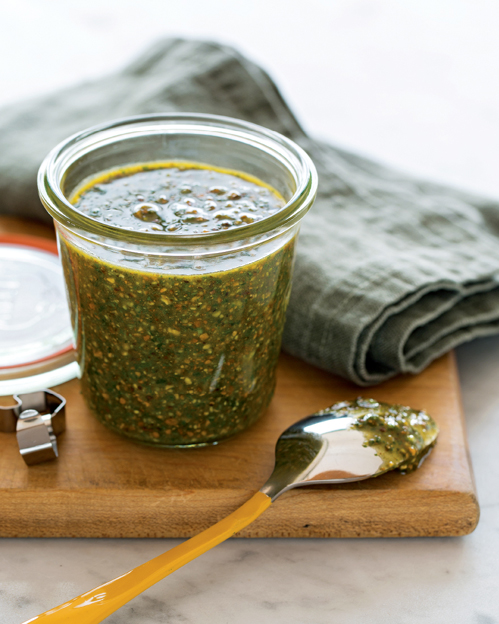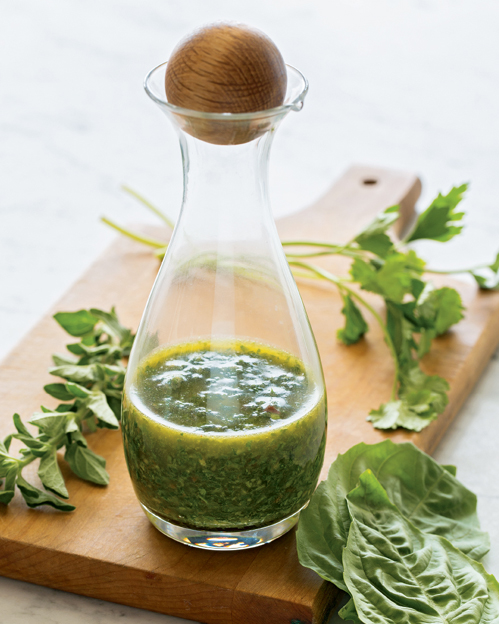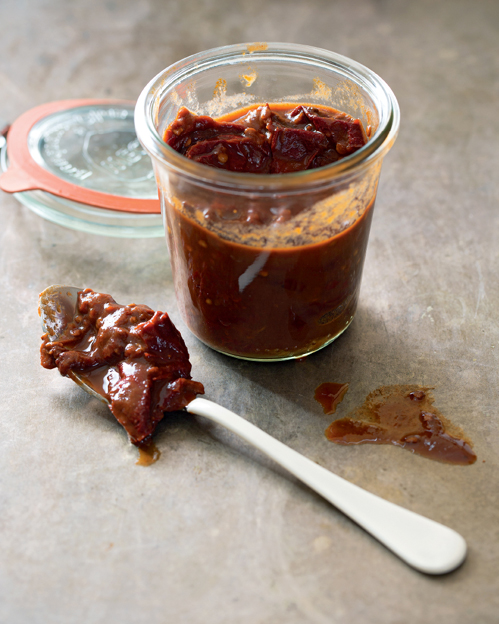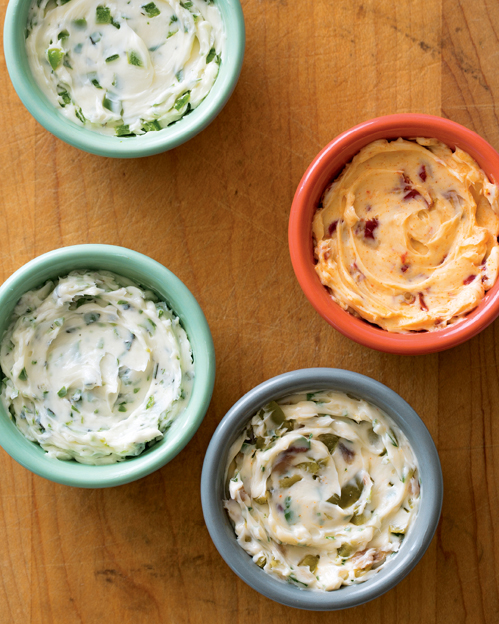Chapter 8
SAUCES & SALSAS from Scratch
Making your own sauces, bases and condiments is more rewarding than buying them, and results in healthier dishes packed with flavor. Homemade broth gives soups and sauces depth and complexity that cannot be achieved with store-bought varieties. Homemade salad dressings made with fresh herbs and fresh oils are aromatic, have phenomenal flavor and lack the sugar that you often find in prepackaged varieties.
A homemade stock, or broth, is the foundation of most well-prepared entrees and is essential for good home cooking. Homemade bone broth is one of the most nutrient-dense foods, rich in collagen, amino acids, gelatin and many minerals. The form calcium takes in bone broth is very easy for the body to absorb and digest. Research and observation of traditional cultures that cook with bones has taught us that gelatin has many benefits, including improving digestion and soothing the gastro intestinal tract. In addition, gelatin has been found to build strong cartilage and bones and also benefits the skin, immune system and heart. Gelatin and bone broth are true superfoods!
Most sauces, salsas, salad dressings and mayonnaise are simple to create at home. When making these items from scratch, you avoid questionable ingredients such as preservatives, vegetable oils and high-fructose corn syrup that are found in many store-bought varieties.
Whipping up sauces and salsas from scratch may take a few extra minutes, but you will be rewarded with a more delicious and healthier meal. Well worth the effort!
CHICKEN BROTH
MAKES 10–12 CUPS/2400–2840 ML
Although the heads and feet are listed as optional, I highly recommend that you include them when making broth, as these are the most gelatinous parts of the animal. Chicken skin is rich in collagen, and also a great addition to broth.
If you don’t have all the vegetables on hand, just skip them. Each adds more depth and flavor to broth, but no one vegetable is necessary. The only three ingredients that are necessary are the bones, water and vinegar!
INGREDIENTS
3 lbs/1 kg chicken pieces (carcass, including necks and backs)
2 chicken heads (optional)
4 chicken feet (optional)
1 leek, cut into several pieces (white and green parts)
1 large onion quartered
2 carrots, peeled and cut in half
2 ribs celery, cut in half
2 bay leaves
10 sprigs parsley
8–12 cups/2–3 L filtered water
1 tbsp/15 ml apple cider vinegar
COOKING INSTRUCTIONS
Place the bones, chicken heads and feet (if using) in the slow cooker. Add the vegetables, bay leaves, water and apple cider vinegar. Cook on low for 10–12 hours. Remove all vegetables and bones and put broth through a strainer. Refrigerate overnight. The fat will have solidified at the top by the next day. Remove fat and discard or reserve for another use. Discard bay leaves. Refrigerate broth and use within a few days or freeze.
CHEF’S TIP
Make broth using a whole chicken. Allow broth to cool, remove meat from the carcass and use it for chicken salad or casseroles.
BEEF BROTH
MAKES 10–12 CUPS/2400-2840 ML
Adding roasted bones and vegetables to broth makes it more aromatic and flavorful. If you are in a hurry, throw your bones in to the slow cooker with filtered water and apple cider vinegar. You will still make a nutritious broth that will be much more flavorful than any store-bought variety. When you do have the time, I recommend taking the extra steps.
INGREDIENTS
4 lbs/2 kg beef bones
1 medium onion, quartered
2 carrots, peeled and cut in half
2 stalks celery, cut in half
4 sprigs thyme
1 bay leaf
8–12 cups/2–3 L filtered water
1 tbsp/15 ml apple cider vinegar
COOKING INSTRUCTIONS
Preheat oven to 450°F/232°C. Place the bones in a roasting pan and roast uncovered for 30 minutes. Transfer the bones to the slow cooker. Add the vegetables, thyme, bay leaf, water and apple cider vinegar. Cook on low for 8–24 hours. Remove all vegetables and bones, and put broth through a strainer. Refrigerate overnight. The fat will have solidified by the next day; remove it and discard or reserve for another use. Discard thyme and bay leaf. Refrigerate broth and use within a few days or freeze.
CHEF’S TIP
Freeze some broth in wide-mouth mason jars to use for soup. Freeze some in muffin tins and, once frozen, transfer to a plastic bag and store in freezer. These ½ cup/120-ml portions are the perfect slow-cooker recipes!
HOMEMADE KETCHUP
MAKES 2 CUPS/470 ML
Homemade ketchup isn’t for everyone. Some of us are more attached to the familiar taste of store-bought ketchup. For me, store-bought ketchup was always too sweet, even more so since I’m eating Paleo.
This ketchup is light, sweet, tangy and has depth.
INGREDIENTS
2 tbsp/30 g ghee
1 cup/150 g onions, diced
1 tbsp/10 g garlic, minced
¼ bunch thyme, tied with kitchen string
3 lbs/1 kg tomatoes, peeled, seeded and diced
¼ cup/60 ml maple syrup
⅓ cup/80 ml apple cider vinegar
¼ cup/60 ml tomato paste
1 bay leaf
½ tsp dry mustard powder
⅛ tsp cayenne
¼ tsp allspice
⅛ tsp crushed red pepper
2 tsp/10 g sea salt
COOKING INSTRUCTIONS
Heat a large skillet over medium-high heat. Add the ghee. Brown onions until soft, about 5 minutes. Add the garlic and sauté for 1 minute. Add the remaining ingredients. Bring to a boil, then simmer for 40 minutes, until slightly thickened.
Discard the thyme. Allow the sauce to cool and either purée with an immersion blender or transfer to a regular blender and purée until smooth. Return the ketchup to the pan and simmer for 1 hour, stirring occasionally. If stored in an airtight container, the ketchup can be kept in the fridge for up to a month.
CHEF’S TIP
Your ketchup will be as good as your tomatoes! It’s best to make this recipe with organic tomatoes when they are in season.
HOMEMADE COCONUT MILK (THE EASY WAY)
MAKES 3-4 CUPS/700-950 ML
We try to limit our use of canned coconut milk. You can find some BPA-free brands, but most of them have additional ingredients such as guar gum. I still think the healthiest option is to make it yourself!
You can make coconut milk using various methods, including making it from desiccated coconuts or from fresh coconuts. The latter takes a fair amount of work. This method relies on a store-bought package of shredded coconut.
INGREDIENTS
8 oz/227 g package of finely shredded coconut
3–4 cups/700-950 ml of hot water, not boiling
COOKING INSTRUCTIONS
Place coconut and hot water in blender for about 45 seconds. Line a strainer with 2 layers of cheesecloth or use a nut milk bag. Pour the contents of the blender through the strainer and into a large bowl. Pull the edges of the cheesecloth together and squeeze out the remainder of the coconut milk. Refrigerate the coconut milk and use within 1–2 days.
CHEF’S TIP
Depending on your need, vary the amount of water. Less water will give you a creamier coconut milk. If you are making the milk to add to smoothies or a recipe that doesn’t require a lot of cream, use more water and make more milk from one package. Coconut milk freezes well in freezer-safe glass jars!
PISTACHIO PESTO
MAKES ABOUT 2 CUPS/470 ML
Pesto is so versatile: herbs and nuts can be mixed and matched to provide endless flavor options. I have yet to meet a pesto that I didn’t like, at least just a little bit!
Pistachios replace the traditional pine nut in this pesto recipe, adding depth to the flavor. Bonus: They are more affordable than pine nuts.
INGREDIENTS
1 ½ cups/40 g fresh basil
½ cup/20 g fresh parsley
1 tbsp/3 g fresh mint
¾ cup/125 g dry-roasted
pistachios, shelled
1 clove garlic
¼ cup/60 ml fresh lemon juice
½ tsp lemon zest
½ tsp sea salt
¼ tsp pepper
¾ cup/180 ml extra-virgin olive oil
COOKING INSTRUCTIONS
Combine basil, parsley, mint, pistachios, garlic, lemon juice, lemon zest, salt and pepper in a food processor until coarsely chopped. Add the oil and process until fully incorporated and smooth. Adjust salt and pepper to taste.
CHEF’S TIP
Pistachio pesto is excellent with eggs, added to lettuce wraps or served with zucchini noodles and my Lemon-Garlic Chicken.
FOUR-HERB SPICY CHIMICHURRI
MAKES ABOUT 2 CUPS/470 ML
Chimichurri is an Argentinian sauce typically served with grilled meats. I first had it in 2004 when I visited Argentina, and later again when I spotted a recipe. I have been making many variations since. This four-herb version is my favorite.
INGREDIENTS
1 cup/40 g fresh parsley
½ cup/20 g fresh cilantro
¼ cup/10 g fresh basil
1 tbsp/3 g oregano
2 tbsp/20 g white onion, chopped
2 tbsp/20 g red bell pepper chopped
1 serrano pepper, chopped
3 cloves garlic
½ tsp sea salt
½ tsp pepper
½ tsp cumin
1 tsp/7 g chili powder
6 tbsp/90 ml extra-virgin olive oil
2 tbsp/30 ml red wine vinegar
COOKING INSTRUCTIONS
Mix all ingredients in a food processor. Pulse a few times until blended but still coarse.
CHEF’S TIP
The chimichurri can be served immediately, but the flavors are greatly improved after a few hours.
BLANCHING AND PEELING TOMATOES
I rarely use canned tomatoes, as I can easily cut, peel and chop them myself! Blanching tomatoes is healthier and less wasteful than buying canned, as you minimize your use of packaging!
INGREDIENTS
up to 8 tomatoes per round of blanching
COOKING INSTRUCTIONS
Boil about 4 quarts of water. Set up a cold-water bath by placing water and ice cubes in a large bowl. Cut an “x” in the bottom of each tomato, carefully drop in the boiling water and cook for 1 minute or until skin starts to break. Remove a few tomatoes at a time and dunk in the cold bath. You should be able to easily peel the skin off by hand. Peel the skin, cut the tomatoes in half and scoop or squeeze the seeds out. Use as needed.
CRISPY SAGE
SERVES 8
Delicate and crunchy with a wonderfully piney flavor, crispy sage adds an impressive touch to burgers or roasted sweet potatoes.
INGREDIENTS
1 bunch fresh sage
3 tbsp/45 g butter
coarse sea salt
COOKING INSTRUCTIONS
Pinch off leaves from sage. Heat butter in a medium-sized skillet over medium-high heat until hot. Watch closely so as not to burn. Fry the sage leaves in batches, taking care not to overcrowd the pan. Place them stem-side up and cook for 30 seconds each until crispy and very lightly browned. Transfer to a paper towel and sprinkle with sea salt.
CHIPOTLE PEPPERS IN ADOBO SAUCE
MAKES ABOUT 2 CUPS OR 7–10 PEPPERS
Chipotle peppers in adobo sauce are one of my favorite ingredients. They add smoky heat and depth to otherwise simple dishes such as fruit salsa.
I stopped using them when I started following a Paleo diet, as many of the canned varieties are loaded with questionable ingredients. I finally made my own recipe that tastes identical to the store-bought version.
INGREDIENTS
7-10 chipotle peppers, stems removed and split lengthwise
1 cup/160 g strained tomatoes in a jar
1 cup/240 ml Beef Broth
¼ cup/60 ml apple cider vinegar
¼ cup/40 g onion, minced
2 cloves garlic, crushed
2 tbsp/45 g raw honey
½ tsp sea salt
½ tsp cumin
¼ tsp cinnamon
⅛ tsp allspice
pinch of cloves
COOKING INSTRUCTIONS
Combine all of the ingredients in a pan, bring to a simmer, cover and simmer on low for 30 minutes. Remove the lid and simmer on low for an additional 30 minutes to allow the sauce to thicken. Once the sauce has thickened, cool sauce and peppers and store for later use. They should keep in the fridge for about a week, or you can freeze them for later use.
CHEF’S TIP
Freeze these in ice-cube trays and use as needed.
GHEE
MAKES ABOUT 1½ CUPS/ 350 ML
Ghee is butter that has been simmered and the milk solids are removed, leaving pure butter, fat or ghee (the Hindi word for fat).
There is a slight difference between clarified butter and ghee. Ghee is simmered longer to brown the milk solids and add a slightly nutty flavor.
Clarified butter and ghee are preferable for high-heat cooking, as both have a higher smoke point and don’t burn as easily as butter.
Making it is quite easy!
INGREDIENTS
1 lb/455 g unsalted butter, from grass-fed cows
COOKING INSTRUCTIONS
Using a medium-sized saucepan, melt butter over very low heat. It will start to separate into components. Let it simmer until you see a layer of foam at the top; this could take 30–60 minutes. When it seems like no more foam is rising, take the butter off the heat and use a ladle to skim off the foam. Using a sieve covered with cheesecloth, pour the butter fat through the cheesecloth into a glass storage bottle. All the milk solids will be left behind. You should have a translucent, pure butterfat. Ghee can be stored in the refrigerator or on the countertop.
HORSERADISH
MAKES ABOUT ½ CUP/ 120 ML
Like most packaged foods, some brands of prepared horseradish have some questionable ingredients. Luckily, making your own from horseradish root is very easy! Homemade horseradish will last in the refrigerator for 3 to 4 weeks.
INGREDIENTS
4–5-inch/10–12-cm long piece of horseradish root, peeled and chopped
6 tbsp/90 ml filtered water
1 tbsp/15 ml white vinegar
¼ tsp sea salt
COOKING INSTRUCTIONS
Place the horseradish pieces in a food processor. Add a tablespoon/15 ml of water. Keep adding water by the tablespoon/15 ml until the horseradish is well ground. You may need more or less water. Be careful: Ground up horseradish is potent, almost like chopped onions. If your mixture gets too liquidy, strain some of the water. Add a tablespoon of vinegar and salt and continue to pulse to combine. Transfer the horseradish to an airtight jar. It will keep in the refrigerator for 2 to 3 weeks.
CHEF’S TIP
The vinegar will stabilize the degree of hotness. If you prefer hot horseradish, wait a minute or two; if you prefer mild, add vinegar right away.
FLAVORED BUTTERS
MAKES 1 CUP
I keep flavored butters in the freezer and use them to fancy up simple meals like a roast, grilled steak or panfried fish. They can transform a simple meal into a special meal. You can make flavored butters with just about anything in your fridge, but here are some of my favorite combinations.
INGREDIENTS
FOR JALAPEÑO CILANTRO BUTTER:
8 oz/230 g butter, softened
1 jalapeño, minced
3 tbsp/8 g cilantro, minced
1 garlic clove, roasted and minced
1 tsp/5 g lemon zest
1 tbsp/15 ml fresh lemon juice
FOR HERB BUTTER:
8 oz/230 g unsalted butter, softened
⅛ tsp sea salt
1 tbsp/3 g each fresh parsley, basil, chervil, chopped
1 tsp/1 g fresh oregano
squeeze of fresh lemon juice
FOR SUN-DRIED TOMATO BUTTER:
8 oz/230 g unsalted butter, softened
3 tbsp/30 g sun-dried tomatoes, chopped
⅛ tsp sea salt
1 small garlic clove, roasted
1 tsp/1 g smoked paprika
FOR ANCHOVY BUTTER:
8 oz/230 g unsalted butter, softened
4 anchovies, chopped
2 garlic cloves, roasted
3 tbsp/8 g flat-leaf parsley, chopped
3 tbsp/35 g green olives, chopped
pinch of dried red pepper
COOKING INSTRUCTIONS
Combine all ingredients for each type of butter and use your hands to mix ingredients until well combined. Roll into a log shape, wrap in parchment paper and store in the fridge.
CHEF’S TIP
Make several varieties, store in ice-cube trays and use whenever your meal needs a hit of flavor!
MANGO SALSA
SERVES 4-6
This simple salsa can be served with my coconut shrimp appetizer (Coconut Shrimp with Mango Salsa), and also is excellent with roasted or grilled fish.
INGREDIENTS
1 jalapeño, seeded and minced
1 ripe mango, peeled, pitted and diced
1 tbsp/10 g red onion, chopped
1 tbsp/3 g cilantro, chopped
½ tbsp mint, chopped
¼ tsp red chili flakes
1 tbsp/15 ml fresh lime juice
1 tbsp/15 ml extra-virgin olive oil
¼ tsp sea salt
⅛ tsp pepper
COOKING INSTRUCTIONS
Combine all salsa ingredients in a medium bowl. Adjust salt and pepper to taste.
FIERY FRUIT SALSA
SERVES 6-8
Though Fiery Fruit Salsa used to be my favorite salsa, I hadn’t made it in years because it called for a chipotle pepper in adobo sauce. The ingredients in canned chipotle peppers are often questionable; some even contain wheat flour. This salsa would not be the same without these smoky peppers, which I now make from scratch (Chipotle Peppers in Adobo Sauce).
The smoky heat of the chipotle pepper perfectly complements the sweetness of the pineapple perfectly.
INGREDIENTS
2 cups/400 g chopped fresh pineapple
2 Roma tomatoes, chopped
1 small red onion, diced (approximately ¼ cup/40 g)
1 chipotle pepper in adobo sauce, finely chopped
1 tbsp/15 ml of adobo sauce
2 tbsp/30 ml extra-virgin olive oil
juice of 1 orange
juice of ½ lime
2 large avocados, chopped
COOKING INSTRUCTIONS
Combine all ingredients, except avocado, in a medium-sized bowl. When all ingredients are combined, fold in avocado without smashing.
CHIPOTLE LIME VINAIGRETTE
MAKES ½ CUP/120 ML
This is a perfect dressing to spice up a simple fajita salad.
INGREDIENTS
2 limes, juiced
1 tsp/7 g raw honey
1 clove garlic, crushed
zest of a lime
⅛ tsp cumin
⅛ tsp chili powder
2 tbsp/5 g cilantro, minced
¼ cup/60 ml extra-virgin olive oil
sea salt and pepper to taste
COOKING INSTRUCTIONS
In a small bowl, whisk together lime juice, honey, garlic, lime zest, cumin, chili powder and cilantro. Slowly whisk in olive oil. Add salt and pepper to taste.
HERBED BALSAMIC VINAIGRETTE
MAKES ABOUT 1 CUP/236 ML
We make fresh balsamic vinaigrette weekly. The dressing is quick to make and the herbs brighten up a simple green salad.
INGREDIENTS
¼ cup/60 ml and 2 tbsp/30 ml balsamic vinegar
1 tsp/5 ml stone-ground mustard
½ tsp sea salt
½ tsp pepper
1 tbsp/3 g parsley, minced
2 tsp/40 g chives, minced
1 tsp/1 g tarragon, minced
½ cup/120 ml extra-virgin olive oil
COOKING INSTRUCTIONS
In a medium bowl, whisk together balsamic vinegar, mustard, salt, pepper and herbs. Slowly whisk in olive oil. Adjust salt and pepper to taste.
CHEF’S TIP
For best results use high-quality olive oil and vinegar.
HOMEMADE MAYONNAISE
MAKES ABOUT 1 CUP/120 ML
There are a variety of ways to make homemade mayonnaise, but this one is my favorite. The key to making a good homemade mayonnaise is to use a mild-tasting extra-virgin olive oil.
INGREDIENTS
1 egg yolk, room temperature
1 tsp/5 ml Dijon mustard
1 tbsp/15 ml lemon juice
¼ tsp sea salt
¼ tsp pepper
1 cup/240 ml mild-tasting extra-virgin olive oil
COOKING INSTRUCTIONS
Place the egg yolk, mustard, lemon juice, salt and pepper in the bowl of a food processor fitted with the blade. While it’s running, add the olive oil to the insert. The insert should have a tiny hole in it that will allow the oil to slowly drip into the food processor. Leave the food processor running until all of the oil has dripped through. This emulsification process is key when making mayonnaise. Adjust salt and pepper to taste.
HOME CURRIED MAYONNAISE
MAKES ABOUT 1 CUP/120 ML
This mayonnaise tastes fantastic in an Asian-inspired chicken salad or Curried Cabbage Salad.
INGREDIENTS
1 egg yolk, room temperature
1 tsp/5 ml stone-ground mustard
1 tbsp/15 ml fresh lemon juice
¼ tsp sea salt
¼ tsp pepper
1 cup/240 ml mild-tasting extra-virgin olive oil
1 tsp/1 g mild curry powder
COOKING INSTRUCTIONS
Place the egg yolk, mustard, lemon juice, salt and pepper in the bowl of a food processor fitted with the blade. While it’s running, add the olive oil to the insert. The insert should have a tiny hole in it that will allow the oil to slowly drip into the food processor. Leave the food processor running until all of the oil has dripped through. This emulsification process is key when making mayonnaise. Add the curry powder and give the food processor a quick whirl. Adjust salt and pepper to taste.
HOMEMADE WASABI MAYONNAISE
MAKES ABOUT 1 CUP/120 ML
For a quick and healthy appetizer, drizzle this mayonnaise over Smoked Salmon Nori Wraps.
INGREDIENTS
1 egg yolk, room temperature
1 tsp/5 ml stone-ground mustard
1 tbsp/15 ml fresh lemon juice
¼ tsp salt
¼ tsp freshly ground black pepper
1 cup/240 ml mild-tasting extra-virgin olive oil
2 tsp/2 g wasabi powder
pinch of cayenne
COOKING INSTRUCTIONS
Place the egg yolk, mustard, lemon juice, salt and pepper in the bowl of a food processer fitted with the blade. While it’s running, add the olive oil to the insert. The insert should have a tiny hole in it that will allow the oil to slowly drip into the food processor. Leave the food processor running until all of the oil has dripped through. This emulsification process is key when making mayonnaise. Add the wasabi powder and cayenne and give the food processor a quick whirl. Adjust salt and pepper to taste.
CHEF’S TIP
Read labels carefully and make sure that the wasabi powder is 100 percent wasabi and does not have other ingredients added.







